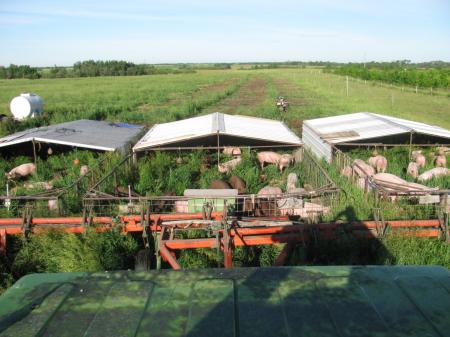 "Animal welfare is everything. If you treat an animal right, they gain better, and the meat will taste better. It's a no brainer,” says Don Ruzicka, Killam, Alberta, who figured out nifty ways to pasture pigs under roof.
"Animal welfare is everything. If you treat an animal right, they gain better, and the meat will taste better. It's a no brainer,” says Don Ruzicka, Killam, Alberta, who figured out nifty ways to pasture pigs under roof.
His pigs get fresh pasture twice a day, shade, and a shower when it was hot, and plenty of feed and water on demand. His mobile hog shelters slide through the grass with ease and make U-turns just as smoothly. Everything is geared to having happy hogs.
Pasture hogs have been a moneymaker for Ruzicka and his wife, Marie. They have grossed as much as $49,700 pasturing hogs and poultry on 9.35 acres, a small part of their 640-acre, all-pastured livestock operation. Key to that return are his mobile shelters. He built 3 for hogs that each take 20 hogs to market, buying at a discount and selling at a premium.
"My pigs came from a purebred breeder who culled any gilts with too much back fat," says Ruzicka. "Good back fat is just what I want. I raise them on pasture with supplemental feed and sell the pork to customers who come to the farm."
Frameworks for the shelters are mostly 1-in. steel tubing, except for the runner members, which are 1 1/2-in. tubing.
"I welded up the frame for each 34-in. high side of the 16 by 32-ft. shelters, laid them on the ground, and then tack-welded 34-in. high by 16-ft. long hog panels to them," says Ruzicka. "I stiffened the structure by running a 32-ft. length of steel tubing from front to back at ground level."
A second length of tubing connects the tops of the side panels at their midpoints. It further strengthens the structure, but also serves two other functions. One was to provide support for the roof panels that cover the back half of the pen. A 4-ft. length of steel tubing welds to it and the front to back stiffener tube. A second upright welds to the middle of the rear panel. A steel tube running from the top of one upright to the other serves as a ridge beam.
The midpoint stiffener also carries a length of 3/4-in. water line halfway across it. Turn a valve and water flows out the end of the line.
"When it gets hot, I turn on the water line, and the pigs wallow under it until cool," recalls Ruzicka. "Then they get up and go eat. Without the cooling shower, they just sleep all day."
A second water line runs to the front center of each mobile pen. It feeds a nipple waterer. All the waterlines connect to a 450-gal. tank mounted on a salvaged sprayer carriage with dual wheels.
"The tank provides enough water for 60 hogs for 3 to 4 days, depending on the heat," says Ruzicka. "The tank sits up high enough to provide gravity feed to the nipple waterers and the showers."
The only negative Ruzicka found to the gravity feed was dripping nipples, as they were designed to be under pressure. The leak provided pigs the opportunity to start rooting out a mud hole, but he had the solution.
He cut out 2 by 3-ft. pieces of plywood and attached them to the front frames under the nipples. The hogs stepped on the panel to reach the nipple instead of standing on wet dirt and starting to dig.
To make the pens mobile, Ruzicka mounted each front corner on skis salvaged from the family's old snowmobiles. While each could easily be pulled by itself, Ruzicka found a way to pull them in unison. He hooked them to the toolbar of an old rod weeder after stripping it down.
"I bought it in 1969, and it sat in the boneyard for years," says Ruzicka. "When it unfolded, it was just about long enough to hook up to the 3 shelters, but adding a couple feet of space between them required extending the ends by a few feet."
Initially Ruzicka had the shelters side by side, but the first time he tried turning, it didn't work. Adding 2 ft. between was just enough space.
"I keep an old tractor hooked up to the toolbar and pulled the water trailer with an old pickup," says Ruzicka. "When the water tank runs low, I just pull it back to the buildings and refill it."
Ruzicka also pastures poultry, both broilers and turkeys, using 12 by 24-ft. shelters he can pull with a quad. Covered with tarps, they worked well, with only one problem.
"In high winds they’re like a kite," says Ruzicka. Eventually he converted one of his hog shelters to poultry by raising the roof to a 6-ft. peak and wrapping panels in chicken wire.
"The hog shelters are heavy enough that they never move with the wind," says Ruzicka.
Ruzicka and his wife stopped raising hogs and poultry when they recently put their farm on the market.
"We've farmed in harmony with Mother Nature since we took a holistic management course in 1996," says Ruzicka. "We've planted 60,000 trees since 2003, and all our waterways and wetlands are fenced off. We give back to nature as nature feeds us."
Contact: FARM SHOW Followup, Don Ruzicka, Box 579, Killam, Alta. Canada T0B 2L0 (780 385-2474; www.sunrisefarm.ca).
1-800-834-9665
Pigs Pastured Under Roof And On The Go
FARM SHOW Magazine » Pigs Pastured Under Roof And On The Go
Pigs Pastured Under Roof And On The Go
